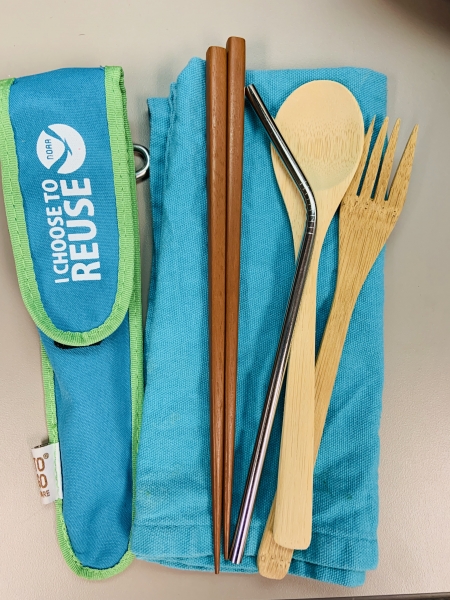No matter where you live, your daily decisions can have a meaningful impact on the Great Lakes, waterways, and ocean near you. Everyday trash can travel from a landlocked state, down a storm drain, into a river, and out to sea. According to the International Coastal Cleanup report of 2018, items such as food wrappers, straws, and plastic take out containers all made the “top ten items collected” during last year’s cleanup. What do all of these items have in common and how can we help to lessen the amount collected? One place to start is with school lunches.
As summer slowly sizzles to a close, parents and teachers find themselves preparing to go back to school. Packed lunches and/or take-out food become the staple meal, especially for those with busy schedules. These items are frequently wrapped, carried, or accompanied by single-use containers and silverware. As you prepare for the new school year, take a moment to consider your lunch choices, including the items you pack in your lunches or choose to purchase in a cafeteria. With just a few simple changes, you can prevent your lunch waste from becoming marine debris.
At Home/Work
If possible, pack a lunch with reusable silverware, cloth napkins, and reusable lunch baggies. Try out durable materials, such as bamboo silverware and stainless steel drinking straws, that hold up well in the dishwasher and in lunch boxes. Lunch baggies can be created using fabric (an old T-shirt would work!) and stick-on or sewn fasteners. To make the baggies water resistant, sew together your favorite cotton cloth with an old vinyl tablecloth! The benefit to selecting reusable items is that they can be washed and reused over and over and only replaced when the item wears out.

Cafeteria
Not every student or teacher is able to bring a lunch and instead, orders food from school. Cafeterias can produce a lot of waste such as disposable straws, utensils, trays, and food packaging. That makes the cafeteria a potential source of marine debris, and a good place to focus waste-reduction efforts at school. For example, if your cafeteria uses plastic silverware, you can work with school administrators to change the types of utensils available. Or, if your cafeteria offers disposable straws, consider a campaign to say “no thanks” to single-use straws. Middle school students in Falmouth, MA started a “Skip the Straw” campaign in their school that eventually became a Marine Debris Program supported project, reaching the entire community!
Classroom
We throw so much away without thinking about it. A lunch waste audit is an easy school activity to start thinking intentionally about the waste produced during this meal.
Teacher tips for a lunch waste audit:
- Decide with the class how everyone will record their lunch waste (this includes both packed and/or purchased lunches). The Trash Tracker worksheet in An Educator’s Guide to Marine Debris is a great place to start your waste audit.
- Have students write down everything they throw away and/or recycle during lunch for a full week.
- At the end of the week, have students tally the waste they threw away, composted, and recycled, and brainstorm ideas on how they can reduce their trash that may become marine debris.
To build on this activity, conduct a second lunch waste audit at the end of the year to see if students have reduced the amount of trash they produce during lunch. This audit would also make an excellent challenge between classrooms to see which room can produce the least amount of lunch waste after one week! For more classroom ideas, visit the NOAA Marine Debris Program’s website.
Changing the way we pack our school lunches may seem small compared to the large issue of marine debris but little ripples cause large waves. If we can get one classroom to change the way they pack a lunch, they may, in turn, challenge the school to a lunch waste audit event. Through encouragement and actions, schools around the world can begin to turn the tide on plastic waste and marine debris.

I think it is good but at my school, we just started having lunch in the cafeteria and there was a looooong line for lunch and everything in the lunch is plastic but I do not know an alternative because a lot of people have school lunch! also, my family has always had reusable containers in our lunch but some people at my lunch table have plastics bags! I do not know what to do but I want to help the enviroment so if you have any ideas, please
contact me!!